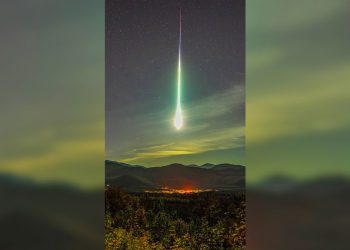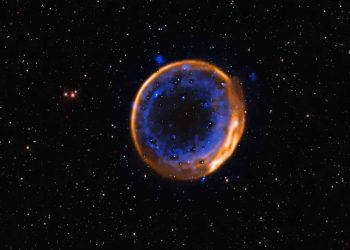Images of small red dots observed in several JWST deep-sky surveys. Credit: ASA/ESA/CSA/STScI/Dale Kocevski (Colby College)
When the James Webb Space Telescope (JWST) began operations, one of its first studies focused on galaxies that existed in the early universe. In December 2022, these observations revealed several objects appearing as “small red dots” (LRD), fueling speculation about what they might be. Although the current consensus is that these objects are compact, primitive galaxies, there is still debate about their composition and what makes them so red. On the one hand, there is the “stellar-only” hypothesis, according to which LRDs are red because they are filled with stars and dust.
This means they could resemble the “dusty galaxies” seen in the universe today. On the other hand, there is the “MBH and galaxy” theory, which posits that LRDs are the earliest examples of active galactic nuclei (AGN) that exist throughout the universe in modern times. Each model has significant implications for how these galaxies subsequently evolved into the types of galaxies observed more recently.
In a recent article published on the arXiv preprint server, an international team of astronomers examined the different scenarios. They concluded that LRDs were originally “stellar-only” galaxies that eventually formed the seeds of supermassive black holes (SMBHs) at the centers of today’s galaxies.
The research was led by Andres Escala, professor of astronomy at the University of Chile. He was joined by colleagues from the Institute for Astronomical Informatics at the University of Heidelberg, Yale University and the Sapienza University of Rome. THE arXiv A paper detailing their findings, “On the Fate of Little Red Dots,” is currently being revised for publication in The Astrophysics Journal.
The discovery of LRDs has mystified astronomers because they possess some characteristics reminiscent of modern astronomical objects, but with some notable differences. For example, the “stellar-only” interpretation posits that LRDs are dusty, intensely star-forming galaxies with extremely dense central regions. This theory explains why these galaxies appear so compact and red, two of the most distinctive characteristics of LRDs. However, the widths of their hydrogen spectral line emissions (Balmer series lines) suggest velocity dispersions much larger than those observed in early galaxies, which would lead to long-term instability.

Webb image showing the first galaxies detected during its general observations of cycle 1. Credit: NASA/ESA/CSA
On the other hand, the MBH interpretation is supported by the presence of broad Balmer emission lines, suggestive of massive black holes at their centers. However, most LRDs do not appear to emit a significant amount of X-rays (which is typical of quasars), and the black holes thought to be present are overmassive compared to their host galaxies. Nonetheless, as Professor Escala told Universe Today via email, these two explanations are considered the most likely for two reasons:
“In addition to having strong evidence, these two predominant interpretations are considered ‘less exotic’ than the alternatives. Nevertheless, LRDs remain objects that have never been observed before at low redshift (z) values. The BH and galaxy interpretation is favorable because such objects are ‘normal’ in the local universe but with different ‘weights’.
However, for LRDs it would represent 10% of the host galaxy (a factor of 100 larger). The stellar-only interpretation of LRDs indicates that they could be just another galaxy like others in the universe, but with one big difference: at least 10 times smaller than the smallest previously observed galaxies (100% versus 1 kpc) and with considerably greater mass. mass.”
In contrast, Escala and colleagues started with a stellar-only interpretation, but considered how LRDs might evolve to fit the interpretation of BH and the galaxy. Their theory would unify these two interpretations by suggesting that they represent different evolutionary stages of these early galaxies. As Escala noted, their theory is supported by essentially the same evidence as the BH and galaxy interpretation. This includes the number of LRDs detectable in X-rays compared to quasars in the more recent universe:
“Under the evolutionary path proposed in our paper, the lack of observed at lower levels. redshifts.”
In short, their theory posits that LRDs will eventually host an MBH because, even in the stellar-only interpretation, the extreme densities of LRDs imply that a good fraction of their internal regions will eventually form a massive black hole that will be over-massive relative to the host. This evolutionary approach to LRDs offers a more complete explanation of Webb’s observations of the early universe. This could have significant implications for our current models of cosmology and galactic evolution, which have been challenged by the recent discovery of these highly compact, deep-red galaxies. Escala says:
“This means that LRDs are probably the most favorable places for the formation of MBHs. Even if these systems are composed only of stars, our work implies that such a star system cannot be stable (at least in its internal regions) and would inevitably tend to form MBHs. Complementing with the other proposed scenarios, in all possibilities, LRDs will be places for ongoing or recent MBHs trained, given that their training is one of the most frequent. open problems of structure formation and cosmology.
More information:
Andres Escala et al, On the fate of the little red dots, arXiv (2025). DOI: 10.48550/arxiv.2509.20453
Powered by Universe Today
Quote: What happened to these “little red dots” observed by Webb? (October 18, 2025) retrieved October 19, 2025 from https://phys.org/news/2025-10-red-dots-webb.html
This document is subject to copyright. Except for fair use for private study or research purposes, no part may be reproduced without written permission. The content is provided for informational purposes only.









